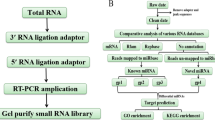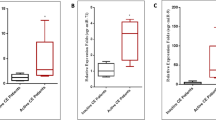Abstract
Cystic echinococcosis (CE) is a neglected helminthic zoonosis caused by the larval stage of the tapeworm Echinococcus granulosus s.l. MicroRNAs (miRNAs) are regulators of gene expression that have been linked with the pathogenesis of several human diseases, but little exists in the available literature about miRNAs in CE. Here, we investigate the expression profiles of 84 microRNAs relevant to the function of lymphocytes and other immune cells during CE infection in the peripheral blood of patients with cysts in active and inactive stages. We applied the microRNA PCR array technology to blood samples from 20 patients with a single hepatic CE cyst in either the active (CE3b) or inactive (CE4–CE5) stage. Our results show a significant upregulation of eight miRNAs (let-7g-5p, let-7a-5p, miR- 26a-5p, miR- 26b-5p, miR- 195-5p, miR- 16-5p, miR- 30c-5p, and miR- 223-3p) in patients with active cysts compared to those with inactive cysts. The high expression of these miRNAs in patients with active cysts suggests their role in a specific host immune response against the infection. Further work in this direction may help shed light on the pathogenesis of human CE.

Similar content being viewed by others
References
Budke CM, Deplazes P, Torgerson PR. Global socioeconomic impact of cystic echinococcosis. Emerg Infect Dis [Internet]. 2006;12:296–303. Available from: http://www.ncbi.nlm.nih.gov/pubmed/16494758. Accessed 6 Nov 2018.
Craig PS, McManus DP, Lightowlers MW, Chabalgoity JA, Garcia HH, Gavidia CM, et al. Prevention and control of cystic echinococcosis. Lancet Infect Dis [Internet] 2007;7:385–94. Available from: http://www.sciencedirect.com/science/article/pii/S1473309907701342. Accessed 6 Nov 2018.
Brunetti E, Kern P, Vuitton DA. Expert consensus for the diagnosis and treatment of cystic and alveolar echinococcosis in humans. Acta Trop. 2010;114:1–16.
Hosch W, Junghanss T, Stojkovic M, Brunetti E, Heye T, Kauffmann GW, et al. Metabolic viability assessment of cystic echinococcosis using high-field 1H MRS of cyst contents. NMR Biomed [Internet]. 2008;21:734–54. Available from: http://www.ncbi.nlm.nih.gov/pubmed/18384178. Accessed 6 Nov 2018.
Lissandrin R, Tamarozzi F, Piccoli L, Tinelli C, De Silvestri A, Mariconti M, et al. Factors influencing the serological response in hepatic Echinococcus granulosus infection. Am J Trop Med Hyg [Internet]. 2016;94:166–71. Available from: http://www.ncbi.nlm.nih.gov/pubmed/26503271. Accessed 6 Nov 2018.
O’Connell RM, Rao DS, Baltimore D. microRNA regulation of inflammatory responses. Annu Rev Immunol [Internet]. 2012;30:295–312. Available from: http://www.ncbi.nlm.nih.gov/pubmed/22224773. Accessed 6 Nov 2018.
Kim VN, Han J, Siomi MC. Biogenesis of small RNAs in animals. Nat Rev Mol Cell Biol [Internet]. 2009;10:126–39. Available from: http://www.ncbi.nlm.nih.gov/pubmed/19165215. Accessed 6 Nov 2018.
Hao S, Baltimore D. The stability of mRNA influences the temporal order of the induction of genes encoding inflammatory molecules. Nat Immunol [Internet]. 2009;10:281–8. Available from: http://www.ncbi.nlm.nih.gov/pubmed/19198593. Accessed 6 Nov 2018.
Tsitsiou E, Lindsay MA. microRNAs and the immune response. Curr Opin Pharmacol [Internet]. 2009;9:514–20. Available from: http://www.ncbi.nlm.nih.gov/pubmed/19525145. Accessed 6 Nov 2018.
Gantier MP. New perspectives in MicroRNA regulation of innate immunity. J Interferon Cytokine Res [Internet]. 2010;30:283–9. Available from: http://www.ncbi.nlm.nih.gov/pubmed/20477549. Accessed 6 Nov 2018.
Cai P, Gobert GN, McManus DP. MicroRNAs in parasitic helminthiases: current status and future perspectives. Trends Parasitol [Internet]. 2016;32:71–86. Available from: http://www.ncbi.nlm.nih.gov/pubmed/26489492. Accessed 6 Nov 2018.
Silakit R, Loilome W, Yongvanit P, Chusorn P, Techasen A, Boonmars T, et al. Circulating miR-192 in liver fluke-associated cholangiocarcinoma patients: a prospective prognostic indicator. J Hepatobiliary Pancreat Sci [Internet]. 2014;21:864–72. Available from: http://www.ncbi.nlm.nih.gov/pubmed/25131257. Accessed 6 Nov 2018.
Macchiaroli N, Cucher M, Zarowiecki M, Maldonado L, Kamenetzky L, Rosenzvit MC. microRNA profiling in the zoonotic parasite Echinococcus canadensis using a high-throughput approach. Parasit Vectors [Internet]. 2015;8:83. Available from: http://www.ncbi.nlm.nih.gov/pubmed/25656283. Accessed 6 Nov 2018.
Cucher M, Macchiaroli N, Kamenetzky L, Maldonado L, Brehm K, Rosenzvit MC. High-throughput characterization of Echinococcus spp. metacestode miRNomes. Int J Parasitol [Internet]. 2015;45:253–67. Available from: http://www.ncbi.nlm.nih.gov/pubmed/25659494. Accessed 6 Nov 2018.
Deplazes P, Rinaldi L, Alvarez Rojas CA, Torgerson PR, Harandi MF, Romig T, et al. Global distribution of alveolar and cystic echinococcosis. Adv Parasitol [Internet]. Elsevier Ltd; 2017;95:315–493. Available from: https://doi.org/10.1016/bs.apar.2016.11.001
Rogan MT, Hai WY, Richardson R, Zeyhle E, Craig PS. Hydatid cysts: does every picture tell a story? Trends Parasitol [Internet]. 2006;22:431–8. Available from: http://www.ncbi.nlm.nih.gov/pubmed/16843726. Accessed 6 Nov 2018.
Zhang Y, Li Y. MicroRNAs in the regulation of immune response against infections. J Zhejiang Univ Sci B [Internet]. 2013;14:1–7. Available from: http://www.ncbi.nlm.nih.gov/pubmed/23303626. Accessed 6 Nov 2018.
Arora N, Tripathi S, Singh AK, Mondal P, Mishra A, Prasad A. Micromanagement of immune system: role of miRNAs in helminthic infections. Front Microbiol [Internet]. 2017;8:586. Available from: http://www.ncbi.nlm.nih.gov/pubmed/28450853. Accessed 6 Nov 2018.
Roush S, Slack FJ. The let-7 family of microRNAs. Trends Cell Biol [Internet]. 2008;18:505–16. Available from: http://www.ncbi.nlm.nih.gov/pubmed/18774294. Accessed 6 Nov 2018.
Lu TX, Rothenberg ME. Diagnostic, functional, and therapeutic roles of microRNA in allergic diseases. J Allergy Clin Immunol [Internet]. 2013;132:3–13; quiz 14. Available from: http://www.ncbi.nlm.nih.gov/pubmed/23735656. Accessed 6 Nov 2018.
Fukumoto I, Hanazawa T, Kinoshita T, Kikkawa N, Koshizuka K, Goto Y, et al. MicroRNA expression signature of oral squamous cell carcinoma: functional role of microRNA-26a/b in the modulation of novel cancer pathways. Br J Cancer [Internet]. 2015;112:891–900. Available from: http://www.ncbi.nlm.nih.gov/pubmed/25668004. Accessed 6 Nov 2018.
Li L, Wei Z, Zhou Y, Gao F, Jiang Y, Yu L, et al. Host miR-26a suppresses replication of porcine reproductive and respiratory syndrome virus by upregulating type I interferons. Virus Res [Internet]. 2015;195:86–94. Available from: http://www.ncbi.nlm.nih.gov/pubmed/25218480. Accessed 6 Nov 2018.
Zhang L, Huang C, Guo Y, Gou X, Hinsdale M, Lloyd P, et al. MicroRNA-26b modulates the NF-κB pathway in alveolar macrophages by regulating PTEN. J Immunol [internet]. 2015;195:5404–14. Available from: http://www.ncbi.nlm.nih.gov/pubmed/26503952. Accessed 6 Nov 2018.
Hotchkiss RS, Tinsley KW, Swanson PE, Schmieg RE, Hui JJ, Chang KC, et al. Sepsis-induced apoptosis causes progressive profound depletion of B and CD4+ T lymphocytes in humans. J Immunol [internet]. 2001;166:6952–63. Available from: http://www.ncbi.nlm.nih.gov/pubmed/11359857. Accessed 6 Nov 2018.
Cimmino A, Calin GA, Fabbri M, Iorio M V, Ferracin M, Shimizu M, et al. miR-15 and miR-16 induce apoptosis by targeting BCL2. Proc Natl Acad Sci U S A [Internet]. 2005;102:13944–9. Available from: http://www.ncbi.nlm.nih.gov/pubmed/16166262. Accessed 6 Nov 2018.
Chen Y-Q, Wang X-X, Yao X-M, Zhang D-L, Yang X-F, Tian S-F, et al. MicroRNA-195 promotes apoptosis in mouse podocytes via enhanced caspase activity driven by BCL2 insufficiency. Am J Nephrol [internet]. 2011;34:549–59. Available from: http://www.ncbi.nlm.nih.gov/pubmed/22123611. Accessed 6 Nov 2018.
Chen C-Z, Li L, Lodish HF, Bartel DP. MicroRNAs modulate hematopoietic lineage differentiation. Science [internet]. 2004;303:83–6. Available from: http://www.ncbi.nlm.nih.gov/pubmed/14657504. Accessed 6 Nov 2018.
Yuan X, Berg N, Lee JW, Le T-T, Neudecker V, Jing N, et al. MicroRNA miR-223 as regulator of innate immunity. J Leukoc Biol [Internet]. 2018;104:515–24. Available from: http://www.ncbi.nlm.nih.gov/pubmed/29969525. Accessed 6 Nov 2018.
Van der Auwera I, Limame R, van Dam P, Vermeulen PB, Dirix LY, Van Laere SJ. Integrated miRNA and mRNA expression profiling of the inflammatory breast cancer subtype. Br J Cancer [internet]. 2010;103:532–41. Available from: http://www.ncbi.nlm.nih.gov/pubmed/20664596. Accessed 6 Nov 2018.
Taïbi F, Metzinger-Le Meuth V, Massy ZA, Metzinger L. miR-223: an inflammatory oncomiR enters the cardiovascular field. Biochim Biophys Acta [Internet]. 2014;1842:1001–9. Available from: http://www.ncbi.nlm.nih.gov/pubmed/24657505. Accessed 6 Nov 2018.
Guo X, Zheng Y. Expression profiling of circulating miRNAs in mouse serum in response to Echinococcus multilocularis infection. Parasitology [internet]. 2017;144:1079–87. Available from: http://www.ncbi.nlm.nih.gov/pubmed/28270244. Accessed 6 Nov 2018.
Jiang S, Li X, Wang X, Ban Q, Hui W, Jia B. MicroRNA profiling of the intestinal tissue of Kazakh sheep after experimental Echinococcus granulosus infection, using a high-throughput approach. Parasite [internet]. 2016;23:23. Available from: http://www.ncbi.nlm.nih.gov/pubmed/27235195. Accessed 6 Nov 2018.
Tamarozzi F, Mariconti M, Neumayr A, Brunetti E. The intermediate host immune response in cystic echinococcosis. Parasite Immunol. 2016;38:170–81.
Acknowledgments
We thank Marcela Cucher (Universidad de Buenos Aires - IMPAM-UBA-CONICET), for critical evaluation and discussion of the manuscript.
Funding
This study was partially supported by funds granted by the EU FP7 Project HERACLES n. 602051 (to E. Brunetti).
Author information
Authors and Affiliations
Corresponding author
Ethics declarations
All patients signed an informed consent form for storage and scientific use of the leftover serum at the moment of blood sampling for routine serology. This retrospective study was performed according to the guidelines of Institutional Review Board of San Matteo Hospital Foundation, Pavia, Italy, on the use of biological specimens for scientific purposes in keeping with Italian Law (art.13 D.L gs 196/2003). All procedures performed in studies involving human participants were in accordance with the 1964 Helsinki declaration and its later amendments or comparable ethical standards.
Conflict of interest
The authors declare that they have no conflict of interest.
Additional information
The published article unfortunately contained mistake. After replacing the image from colored version to black and white, the Figure 1 caption, unfortunately, was left unupdated.
Rights and permissions
About this article
Cite this article
Mariconti, M., Vola, A., Manciulli, T. et al. Role of microRNAs in host defense against Echinococcus granulosus infection: a preliminary assessment. Immunol Res 67, 93–97 (2019). https://doi.org/10.1007/s12026-018-9041-4
Published:
Issue Date:
DOI: https://doi.org/10.1007/s12026-018-9041-4




